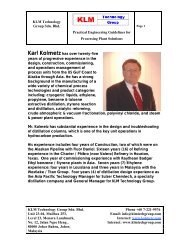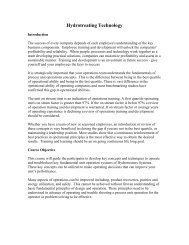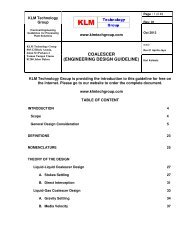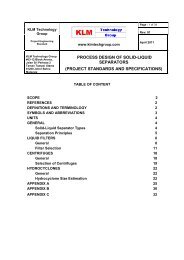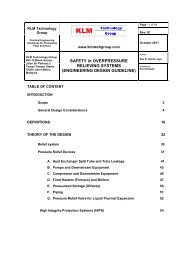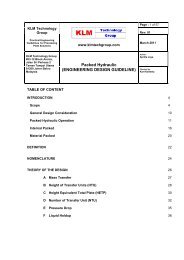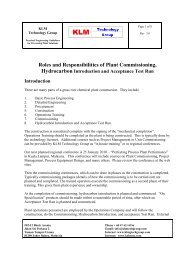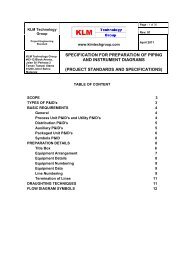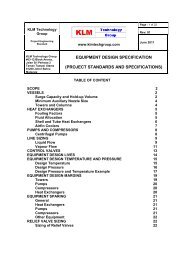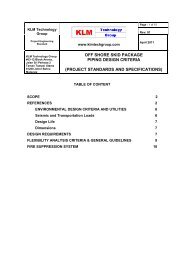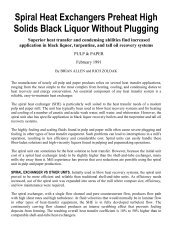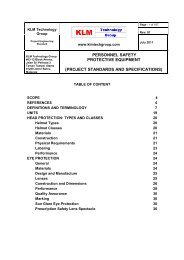air separation units (engineering design guideline) - KLM ...
air separation units (engineering design guideline) - KLM ...
air separation units (engineering design guideline) - KLM ...
Create successful ePaper yourself
Turn your PDF publications into a flip-book with our unique Google optimized e-Paper software.
<strong>KLM</strong> TechnologyGroupPractical EngineeringGuidelines for Processing PlantSolutionsAIR SEPARATION UNITS(ENGINEERING DESIGN GUIDELINES)Page 11 of 69Rev: 01Jan 2013Vacuum Pressure Swing Adsorption (VPSA)The Vacuum Pressures Swing Adsorption (VPSA) process is a variation on thePressures Swing Adsorption (PSA) process, which is more applicable forcertain applications. VPSA uses a feed blower instead of an <strong>air</strong> compressor to supply<strong>air</strong> to the system and the purified gas is collected using a vacuum blower to desorb theadsorber vessels. The use of different technology in VPSA results in a significantdecrease in the power consumption of the system. Although power savings are clearwith this system, they are typically cost effective only for plants requiring very largeoxygen producing capacities.Each VPSA system includes a rotary-lobe feed <strong>air</strong> blower, vacuum blower (two bedsystems only), one or two adsorbent vessels, an oxygen surge tank, switching valvesand computer controls.In the single-bed system, the blower draws in <strong>air</strong>, compresses it and sends it to theadsorbent vessel to remove impurities, leaving 90 to 94 percent pure oxygen as theproduct. The adsorbent is then regenerated as the blower removes gas by reducing thepressure inside the vessel. The waste gas (nitrogen, water and carbon dioxide) is thendischarged into the <strong>air</strong>. Since oxygen is not produced during regeneration, the systemincludes a low-pressure surge tank to allow for continuous oxygen supply.The two-bed system uses a similar adsorption process cycle that relies on swings inpressure -- from above one atmosphere to below atmospheric pressure (vacuum) -- tocycle each bed sequentially from adsorption to desorption.One bed is always adsorbing impurities to separate oxygen from <strong>air</strong>, while the other bedregenerates. Thus, the beds alternately produce oxygen into a surge tank whichensures that product is available continuously at a consistent pressure and purity.Comparison of VPSA with PSA and cryogenic <strong>separation</strong>1. Though VPSA systems are more costly to build, they are comparatively moreenergy efficient than PSA systems for the same product flow, pressure and purityconditions.2. Oxygen VPSA <strong>units</strong> are economical than oxygen PSA <strong>units</strong> only when the desiredproduction rate is greater than about 20 tons per day, up to 60 tons per day ormore.These <strong>design</strong> <strong>guideline</strong> are believed to be as accurate as possible, but are very general and not for specific <strong>design</strong>cases. They were <strong>design</strong>ed for engineers to do preliminary <strong>design</strong>s and process specification sheets. The final<strong>design</strong> must always be guaranteed for the service selected by the manufacturing vendor, but these <strong>guideline</strong>s willgreatly reduce the amount of up front <strong>engineering</strong> hours that are required to develop the final <strong>design</strong>. The <strong>guideline</strong>sare a training tool for young engineers or a resource for engineers with experience.This document is entrusted to the recipient personally, but the copyright remains with us. It must not be copied,reproduced or in any way communicated or made accessible to third parties without our written consent.



